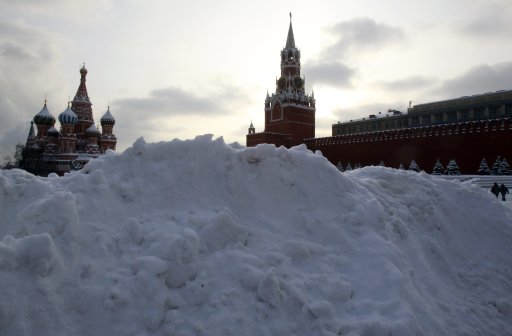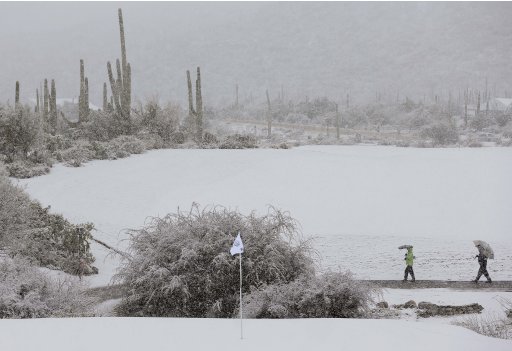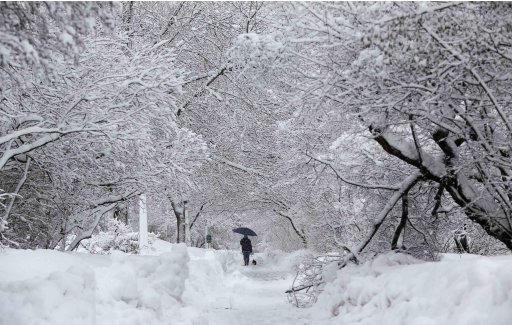February 10, 2013 – BOSTON, MASS - The Northeast started digging itself out after a blizzard dumped up to 40 inches of snow with hurricane force winds, killing at least nine people and leaving hundreds of thousands without power. By early Sunday, utility companies were reporting roughly 350,000 customers still without electricity across a nine-state region after the wet, heavy snow brought down tree branches and power lines. About half a million had been down as of late Saturday. Air traffic began to return to normal Sunday after some 5,800 flights were canceled Friday and Saturday, according to Flightaware, a flight tracking service. Bradley International Airport in Windsor Locks, Connecticut, and Long Island MacArthur Airport reopened on Sunday morning. Both were closed on Saturday. Boston’s Logan International Airport reopened late on Saturday, according to the Federal Aviation Administration. Rare travel bans in Connecticut and Massachusetts were lifted but roads throughout the region remained treacherous, according to state transportation departments. As the region recovered, another large winter storm building across the Northern Plains was expected to leave a foot of snow and bring high winds from Colorado to central Minnesota into Monday, the National Weather Service said. South Dakota was expected to be hardest hit, with winds reaching 50 miles per hour, creating white-out conditions. The storm was expected to reach parts of Nebraska, North Dakota, Wyoming and Wisconsin. Friday and Saturday’s mammoth storm stretched from the Great Lakes to the Atlantic and covered several spots in the Northeast with more than 3 feet of snow. Connecticut, Rhode Island and Massachusetts took the brunt of the blizzard. Hamden, Connecticut, had 40 inches and nearby Milford 38 inches, the National Weather Service said. Amtrak said it planned to run a limited service between New York and Boston on Sunday and a regular Sunday schedule from New York to the state capital in Albany. However, the Massachusetts Bay Transportation Authority, the Rhode Island Public Transit Authority and Connecticut Transit said service would remain suspended Sunday. Stratford, Connecticut, Mayor John Harkins told WTNH television on Saturday snow had fallen at a rate of 6 inches an hour and even plows were getting stuck. The storm dropped 31.9 inches of snow on Portland, Maine, breaking a 1979 record, the weather service said. Winds gusted to 83 miles per hour (134 km per hour) at Cuttyhunk, New York, and brought down trees across the region. The storm contributed to at least five deaths in Connecticut and two each in New York state and Boston, authorities said. A motorist in New Hampshire also died when he went off a road but authorities said his health may have been a factor in the crash. The two deaths in Boston were separate incidents of carbon monoxide poisoning in cars, an 11-year-old boy and a man in his early 20s. The boy had climbed into the family car to keep warm while his father cleared snow. The engine was running but the exhaust was blocked, said authorities. –Reuters
 Crustal upheaval near Santa Cruz Islands signals planet undergoing massive change
Crustal upheaval near Santa Cruz Islands signals planet undergoing massive changeFebruary 8, 2013 – SANTA CRUZ, ISLS – The deadly 8.0 earthquake and tsunami that hit the Solomon Islands days ago, struck along a subduction zone, the same geologic setting responsible for the world’s most powerful earthquakes. In a subduction zone, two of Earth’s tectonic plates meet and one slides beneath the other into the mantle, the deeper layer beneath the crust. The Solomon Islands sits above the collision between the Australia and Pacific plates. In the region of the magnitude-8.0 earthquake, the Australia plates dives beneath the Pacific plate toward the east-northeast at a geologically speedy 3.7 inches (94 millimeters) per year, according to the Incorporated Research Institutions for Seismology (IRIS). The earthquake hit at a depth of 17.8 miles (28.7 kilometers) and was the second largest earthquake in the Solomon Islands region in almost 40 years, IRIS said in a statement. Several aftershocks followed; the largest measuring magnitude 6.6, according to the U.S. Geological Survey (USGS). The tsunami generated by the quake, reported as 3 feet (0.9 meters) in height, hit villages on Santa Cruz Island, destroying structures and homes, according to news reports. A tsunami watch was issued for Australia, Indonesia and New Zealand, but not for the rest of the Pacific, according to the West Coast and Alaska Tsunami Warning Center. Subduction zone quakes shove the seafloor in one sudden movement, which may generate a tsunami by pushing the ocean water above. However, depending on the depth and size of the earthquake, the actual seafloor surface may not move a significant amount, so a big earthquake doesn’t always produce a massive wave. For example, a magnitude-7.6 subduction zone earthquake in the Philippines in August 2012, which started deep in Earth’s crust, did not trigger a tsunami. There were dozens of earthquakes around the Solomon Islands in the month leading up to the massive 8.0 earthquake, the USGS reported. More than 40 magnitude-4.5 quakes shook the islands in the past week alone, and seven of those temblors were larger than a magnitude-6.0, the USGS said. –Discovery
Planet in crisis: “We are entering an era of increased planetary instability, brought on by a significant rise in the geothermal gradient, and subsequent magmatic fluid expansion within the planet’s interior. It will be a time, in which, we will see catastrophic and exponential increases in the number of natural disasters- most notably: earthquakes, storms, and volcanic eruptions. Yet, it is not the number of earthquakes that will strike the planet in the future that should most concern us. It will be the cluster eruption of mega-quakes, and their resonate aftermath, which will signal the planet has entered an intensified cataclysmic period of transition…these quakes will signal the secondary stage of Earth’s thermal acceleration, and should come to be viewed as signs of increasing disorder. Some of the quakes will strike as singular events; others will erupt in clusters, and some will strike some of the world’s most dangerous faults…this time will be marked by increased tectonic plate agitation, and an increase in the outbreak of the most powerful and destructive type of earthquakes, known as mega-thrust earthquakes.” –The Extinction Protocol, pp. 166,167,172 (2009)
A blizzard of potentially historic proportions threatened to strike the Northeast with a vengeance Friday, with up to two feet of snow forecast along the densely populated corridor from the New York City area to Boston and beyond.
Crushing Storm to Pile Two Feet on Boston...
HISTORIC, EXTREME SNOW...
THE BIG ONE?
WATCHES/WARNINGS...
BANK OF AMERICA urges run on ATMs...
Winds near hurricane force...
Cripple travel...
“Earth’s stability is collapsing…and one by one, the biospheric processes regulating life itself are going awry. These are early characteristics of climate shock and are indications that even more ominous changes are yet to unfold…areas of the Earth…will become increasingly inhospitable from the extremes of climate change. As incredible as it seems, we’re witnessing signs of epochal change-across the planet which are typically consigned to geological periods of planetary extinctions. The climate stability, we once knew, is gone forever.” –The Extinction Protocol
February 3, 2013 – AUSTRALIA - The Bureau of Meteorology said both the average mean temperature of 29.68 degrees Celsius (85.42 degrees Fahrenheit) and the average mean maximum temperature of 36.92 Celsius surpassed previous records set in January 1932. The nation’s central outback sweltered under a “dome” of heat for much of the month, with the Northern Territory posting its hottest mean temperature on record for January of 31.93 Celsius, the bureau said. “The heat-wave in the first half of January was exceptional in its extent and duration,” it said in a statement released Friday. “The national average maximum temperature on 7 January was the highest on record. Numerous stations set records for the most days in succession above 40 degrees Celsius, including Alice Springs (17 days) and Birdsville (31 days).” The bureau said a large number of weather stations set all-time record high temperatures during the heat-wave, including Sydney (45.8 Celsius on January 18) and Hobart (41.8 Celsius on January 4). The highest temperature recorded during the heat-wave was at Moomba in South Australia, which hit a scorching 49.6 Celsius on 12 January. The bureau said the heat-wave, which aided bushfires in the eastern states, was followed by extreme rainfall and flooding for some coastal areas of Queensland and New South Wales caused by ex-tropical cyclone Oswald. The rain caused extensive flooding in the Queensland towns of Bundaberg, where some houses were washed away and roads destroyed, and Gladstone among others. “Gladstone received 820 millimeters (32 inches) of rainfall in four days, which exceeded its previous record for a whole month, and more than the annual rainfall recorded in 2011 or 2012,” the bureau said. –Physics


 Re: Earth Changes 2013 - Daily Updates
Re: Earth Changes 2013 - Daily Updates

 Re: Earth Changes 2013 - Daily Updates
Re: Earth Changes 2013 - Daily Updates






 Re: Earth Changes 2013 - Daily Updates
Re: Earth Changes 2013 - Daily Updates
 Re: Earth Changes 2013 - Daily Updates
Re: Earth Changes 2013 - Daily Updates
 Re: Earth Changes 2013 - Daily Updates
Re: Earth Changes 2013 - Daily Updates






 Re: Earth Changes 2013 - Daily Updates
Re: Earth Changes 2013 - Daily Updates Re: Earth Changes 2013 - Daily Updates
Re: Earth Changes 2013 - Daily Updates
 Re: Earth Changes 2013 - Daily Updates
Re: Earth Changes 2013 - Daily Updates Re: Earth Changes 2013 - Daily Updates
Re: Earth Changes 2013 - Daily Updates

 Re: Earth Changes 2013 - Daily Updates
Re: Earth Changes 2013 - Daily Updates


 Re: Earth Changes 2013 - Daily Updates
Re: Earth Changes 2013 - Daily Updates
 Re: Earth Changes 2013 - Daily Updates
Re: Earth Changes 2013 - Daily Updates
 Re: Earth Changes 2013 - Daily Updates
Re: Earth Changes 2013 - Daily Updates

 Re: Earth Changes 2013 - Daily Updates
Re: Earth Changes 2013 - Daily Updates


 Re: Earth Changes 2013 - Daily Updates
Re: Earth Changes 2013 - Daily Updates Re: Earth Changes 2013 - Daily Updates
Re: Earth Changes 2013 - Daily Updates
 Re: Earth Changes 2013 - Daily Updates
Re: Earth Changes 2013 - Daily Updates
 Re: Earth Changes 2012 Updates
Re: Earth Changes 2012 Updates

 Re: Earth Changes 2013 - Daily Updates
Re: Earth Changes 2013 - Daily Updates
 Re: Earth Changes 2013 - Daily Updates
Re: Earth Changes 2013 - Daily Updates


 Re: Earth Changes 2013 - Daily Updates
Re: Earth Changes 2013 - Daily Updates
 Re: Earth Changes 2013 - Daily Updates
Re: Earth Changes 2013 - Daily Updates

 Re: Earth Changes 2013 - Daily Updates
Re: Earth Changes 2013 - Daily Updates

 Re: Earth Changes 2013 - Daily Updates
Re: Earth Changes 2013 - Daily Updates
 Re: Earth Changes 2013 - Daily Updates
Re: Earth Changes 2013 - Daily Updates